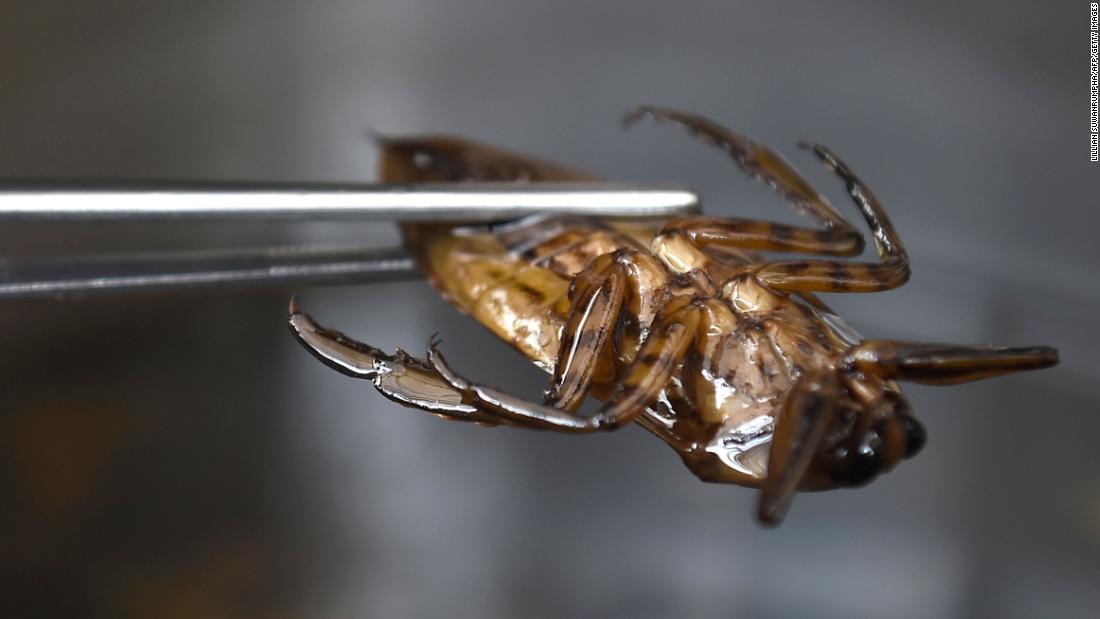[ad_1]
That meal will give you four times the iron, more than three times the protein and more key vitamins and minerals than the bread, smoothie, eggs and bacon you eat today — all while saving the planet.
The US Food and Drug Administration allows 30 or more insect parts and some rodent hair in every bar of chocolate; nearly two maggots in a 16 ounce can of tomatoes or pizza sauce; and up to 450 insect parts and nine rodent hairs in every 16 ounce box of spaghetti.
So why not eat bugs on purpose and simultaneously fight climate change?
Bugs are really good for you
Europe’s on track to do the same, while Asia Pacific nations are expected to eat $270 million worth of insects by the quarter of the century.
A growing demand for high quality protein, along with a movement toward sustainability and against processed foods, are a few of the reasons behind the growing popularity.
Here’s another explanation: Bugs are very good for you.
“I’ve eaten bugs in many countries: termites, scorpions, beetle larvae, grasshoppers, silkworms. All very common,” said entomologist Jeff Tomberlin, who directs the forensic and investigative sciences program at Texas A&M University.
“I had beetle larva that was incorporated into a quiche. I’ve had bamboo worms that were fried like French fries,” he said. “I’ve had termites that were smoked and served as an appetizer, just like peanuts.
“As for the taste, it’s sort of a nutty popcorn flavor,” Tomberlin said. “The buttery flavor would be the fat of the insect and the nuttiness would be the chitin, or the exoskeleton.”
The most commonly eaten insect groups globally, according to the FAO, are ants; beetles; bees; caterpillars; cicadas; crickets; dragonflies; flies; grasshoppers; leaf bugs; locusts; scale insects; termites; and wasps.
And many of those are packed with good-for-you vitamins, minerals, fat and protein. In fact, insects are often considered delicacies.
Queen termites, for example, are so nutritionally dense that they are fed to undernourished children in Uganda and Zambia.
Consider those mealworms you had instead of bacon at our imaginary breakfast. They have higher unsaturated omega-3 levels than fish, as well as the same protein, vitamin and mineral content.
The cricket protein in the toast you hypothetically enjoyed is said to be a “complete protein” just like fish, meat, dairy and eggs. Complete proteins contain all nine essential amino acids needed to build and repair protein tissues in the body. We don’t naturally make those essential amino acids, so we must get them through our diet.
In addition, each insect delivers an enormous punch of protein for its size.
Take the mopane caterpillar, one of the most highly prized and devoured insects in the world. One mopane worm, as they are called, provides between 48% to 61% of protein, and is a source of calcium, zinc and iron.
Then there’s the fat content: 16% to 20% of the mopane worm is fat, of which 40% is essential fatty acids. The fat can add a creaminess to recipes (remember your future breakfast eggs?).
Bugs are good for the planet
And then there’s the biggest selling point: Devouring bugs instead of methane-producing livestock is an easy, excellent way to deliver quality nutrition to the masses of humanity while helping the environment.
That last bit is huge: According to the FAO, over a fourth of the world’s land is used for grazing livestock. Another third of the earth is dedicated to growing crops that will be eaten by livestock.
Just think of it: Bugs can be grown in small cages nested inside insect skyscrapers.
If that is huge, this next fact is gargantuan: Because they are cold-blooded and need less energy to stay warm, bugs need much less food than animals.
“If you look at the production of a pound of beef, you’re looking at a conversion rate of about 20 to 1 — 20 pounds of feed to produce one pound of meat,” Tomberlin said. “If you look at insects, you’re looking at about 2 to 1 ratio. So it’s a much more effective conversion rate.”
If that isn’t enough, there’s yet another plus: the fast life-cycle of insects.
“While you may feed an animal for six weeks to ready it for market, during that same period you (could) have multiple generations of insects,” Tomberlin said. “Add that to the fact that you can raise them in such little space, on so little feed, and you’ve got three ways in which insects are superior food products than livestock.”
Consider the devastating effects of climate change, overfishing, water shortages and a reduced productivity of crop-growing fields, and it’s easy to see how insects will soon be the protein of the future.
Mopane worm hummus, anyone?
[ad_2]
Source link






